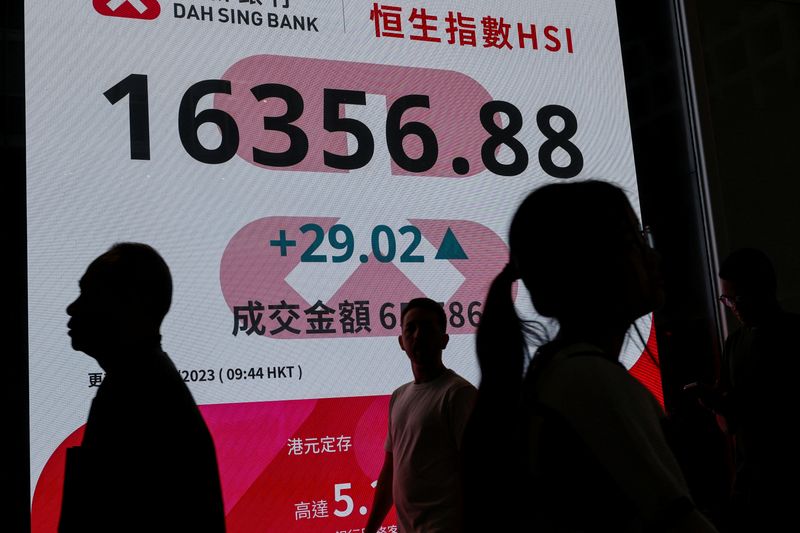SHANGHAI (Reuters) -China's blue-chip stocks slumped to an almost five-year trough on Wednesday while the yuan currency extended losses, as markets grappled with Moody's (NYSE:MCO) cut to China's credit outlook at a time of growing worries about the economy's stuttering recovery.
On Tuesday, the ratings agency issued a downgrade warning on China's A1 sovereign credit rating, the fifth highest level on its ratings scale, saying costs to bail out local governments and state firms and control its property crisis would weigh on the world's second-largest economy.
Moody's followed up its China move with changes to its outlooks on 18 Chinese corporates to negative on Wednesday.
China stocks opened down with the CSI300 Index touching its lowest level since Feb. 2019, before recouping earlier losses. It closed up 0.2%, with the Shanghai Composite Index down by 0.1%.
Chinese markets have had a torrid time this year as a shaky economic recovery and a deepening property crisis have added to geopolitical challenges, including protracted Sino-U.S. tensions over tech and trade.
The CSI300 Index has tumbled about 12% so far this year and is set to record one of the worst performer in the region.
The Hang Seng Index, meanwhile, rebounded and closed up 0.8%, with tech shares leading gains.
"The CSI300 index was hit the hardest in terms of valuation, as the index gets more allocations from foreign investors. Adding the impact of Moody's cut, the index may find a bottom and rebound soon," said Pang Xichun, research director at Nanjing RiskHunt Investment Management Co.
Foreign capital recorded a net inflow via the northbound trading link on Wednesday, after three consecutive sessions of outflows.
"Moody's decision to downgrade its outlook on China's debt is the latest link in a long string of recent disappointments for investors in Chinese equities," said Yasser El-Shimy, investment analyst at The Motley Fool.
China's economic recovery has shown signs of losing steam quickly after an initial burst in consumer and business activity at the start of the year, weighed down by an ailing housing market, local government debt risks and slow global growth.
The cost of insuring China's sovereign debt against a default rose to its highest since mid-November on Tuesday following the Moody's decision. However, yield on China's 10-year government bond rose only a touch on Wednesday.
"The actual investment implication is quite limited,partly because the foreign ownership of Chinese government bond is quite low," said Tai Hui, APAC chief market strategist at J.P. Morgan Asset Management.
Market participants said they will quickly switch their attention to the upcoming Politburo meeting and the annual Central Economic Work Conference this month, which usually discuss policy plans and the outlook for China's economy.
"Without decisive and effective macro policies, market sentiment could remain weak, and Moody's decision could add to the weak sentiment," Citi analysts said in a note.
Responding questions on Moody's cut during a regular press briefing on Wednesday, China's foreign ministry said the country is confident and capable of achieving stable, long-term development.
FRAGILE YUAN
In the currency market, China's yuan slipped against the dollar on Wednesday even as major state-owned banks continued their efforts to stabilise the currency.
The central bank, the People's Bank of China (PBOC), extended its months-long trend of setting daily guidance fix at levels stronger than market projections, which traders and analysts have widely interpreted as an official attempt to keep the currency stable.
On Wednesday, the PBOC set the midpoint rate, around which the yuan is allowed to trade in a 2% band, at 7.1140 per dollar prior to market opening, 13 pips weaker than the previous fix of 7.1127. But it was 336 pips firmer than Reuters estimate of 7.1476.
"The strong yuan fix continues to convey a message of support for the yuan as domestic demand remains fragile and China's property market continues to struggle to find a foothold," Maybank analysts said in a note.
The spot yuan rate opened at 7.1570 per dollar and was changing hands at 7.1571 by 0805 GMT, 91 pips weaker than the previous late session close.
China's major state-owned banks stepped up U.S. dollar selling forcefully after the Moody's statement on Tuesday, and they continued to sell the greenback on Wednesday morning, Reuters reported.
The yuan has had a volatile year, having weakened 6.14% to the dollar at one point before recouping some of the losses on growing bets that U.S. interest rates have peaked.
The yuan strengthened 2.55% in November, its best month this year, but it is still down 3.6% year-to-date.
Other global ratings agencies, Fitch Ratings and S&P Global Ratings, made no changes to their respective China credit ratings.

Fitch affirmed China's A+ rating with a stable outlook in August, while S&P Global said on Wednesday it has retained China's A+ rating with a 'stable' outlook.
"We last affirmed our A+ long term ratings on China in June with stable outlook and there has been no changes to that yet," said S&P in an emailed response to queries from Reuters.